A&M on tour: Der Liedberg EarthCache
A&M on tour: Der Liedberg
-
Difficulty:
-

-
Terrain:
-

Size:  (other)
(other)
Please note Use of geocaching.com services is subject to the terms and conditions
in our disclaimer.
Alberto und Maribel wandern durch den Liedberg
Alberto und Maribel are walking through Liedberg
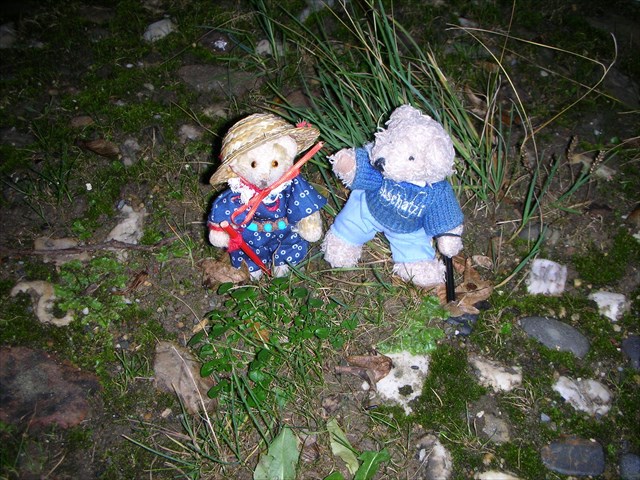
Dies ist ein strenges Naturschutzgebiet! Bitte bleibt nur auf den öffentlichen Wegen! Hunde sind anzuleihnen; für Fahrräder verboten - sie dürfen nicht einmal geführt werden! Haltet euch an die Regeln, es können Bußgelder erhoben werden!
*****
This is a strict nature reserve! Stay on the public ways. Use dog lead. No bikes at all. Respect the rules, otherwise you may have to pay a fine!
DEUTSCH:
"Das, Maribel, ist der Liedberg! Ein ganz besonderer Hügel in der Landschaft." Alberto zeigt auf die Kuppe vor ihnen.
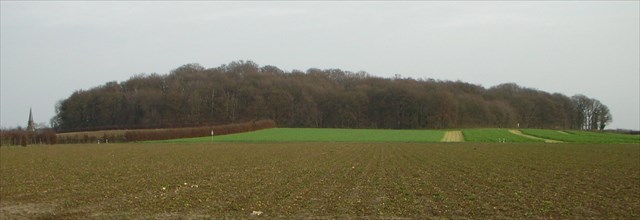
"Und was ist daran so Besonderes?" will Maribel wissen.
"Der Liedberg ist eine der höchsten Erhebungen der rheinischen Tiefebene. Er entstand vor über einer Million Jahren und ist das älteste Natur- und Kulturdenkmal des Rhein-Kreis Neuss. Ein Zeugenberg aus vergangenen Zeiten, und zugleich der einzige Ort mit Festgestein am Niederrhein. Und 'unten drunter' wird es noch interessanter!" Alberto kommt in Fahrt.
"Puh, das ist eine ganze Menge! Dann erkläre mir doch mal zuerst, was ein Zeugenberg ist -- den Ausdruck kenne ich noch nicht." Maribel ordnet ihre Gedanken.
"Wenn ein Einzelberg durch Erosion aus einem erosionsresistenten Gesteinsverband isoliert wird, spricht man von einem Zeugenberg. Er bezeugt quasi die früheren Zusammenhänge." Alberto weiß Bescheid.
"Und wegen des Festgesteins heißt er wahrscheinlich auch 'Quarzitkuppe', oder? Obwohl ich mir das irgendwie 'felsiger' vorgestellt hätte. Die Kuppe ist doch bewaldet."
"Ja, stimmt schon," schmunzelt Alberto. "Die Quarzitblöcke liegen unter der oberen Humusschicht. Unter diesen befindet sich das mächtige Sandlager, noch tiefer gibt es sogar eine Braunkohlenschicht."
"Ah, der Sand ist das 'weiße Gold' Liedbergs," nickt Maribel. "Wobei ich mich frage, wie der Sand wohl unter den Berg kam! Bei Sand denk' ich an Meeresstrand...."
"Richtig! Aber vor 30 Millionen Jahren reichte die Nordsee tatsächlich bis in dieses Gebiet, und sie brachte auch den Sand mit." Alberto holt ein bißchen aus. "Hier wechselten subtropisches Klima mit feucht-üppigem Pflanzenwuchs und Eiszeiten, die Gletscher und Geröll brachten, mehrfach miteinander ab. Selbst Rhein und Maas gaben sich in Liedberg ein Stelldichein."
"Woher weiß man das alles so genau?" Maribel ist skeptisch.
"Jeder Akteur hinterläßt seine Spuren," betont Alberto. "Immer und überall! Das Meer bringt den Sand, die Pflanzen werden zu Braunkohle und Kohle. Die Tektonik hebt, senkt und staucht die Landschaft, Druck und Temperatur verkieseln Sand zu Quarzit -- was zu den Quarzitblöcken des Liedbergs führte. Unser Planet ist geologisch sehr aktiv. Vom Rhein stammen die weißen Kiesel, von der Maas die abgerundeten schwarzen Feuersteine aus den Ardennen, sogenannte 'Maas-Eier'."
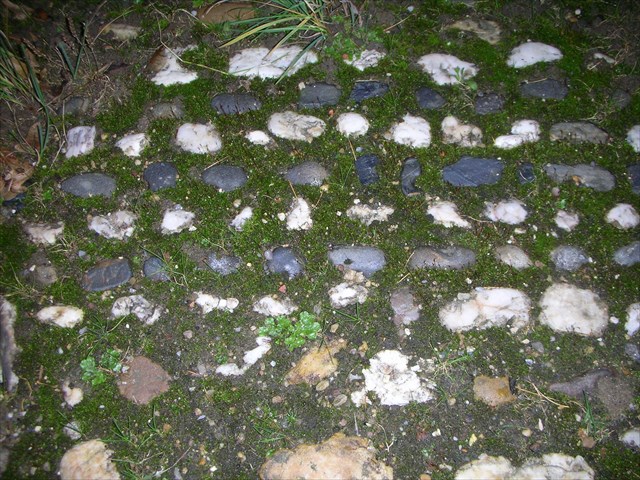
"Und an den Überbleibseln, die man findet, kann man dann die Vergangenheit rekonstruieren", überlegt Maribel. "Laß uns doch mal durch den Wald gehen und schauen, ob wir was finden."
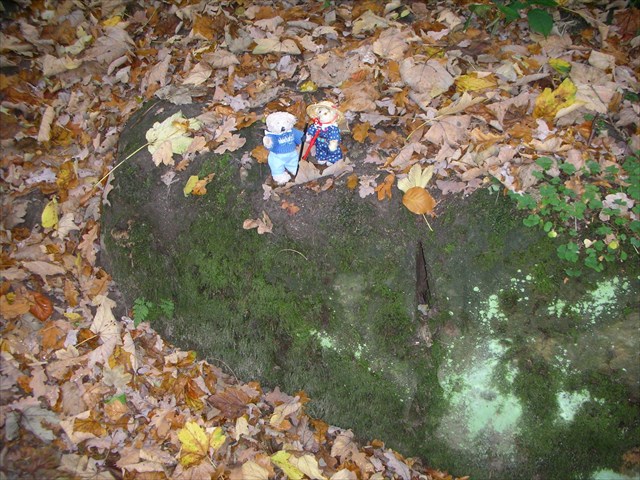
Bei ihrem Spaziergang über die Kuppe müssen sie allerdings schon sehr genau aufpassen, um außer Wald noch irgend etwas von den Quarzitblöcken, Kieseln oder anderen geologischen Spuren zu entdecken. Man sieht auf den ersten Blick nur alten Baumbestand und rechts und links der Wege tiefe Mulden wie von Bombentrichtern oder Vulkankratern.
"Was ist denn hier passiert?" fragt Maribel erstaunt.
"Menschenwerk!" erklärt Alberto. "Die Quarzitblöcke wurden noch im Tagebau gefördert, aber für den feinen Quarzsand trieb man viele Stollen in den Berg und scheffelte den Sand heraus. Natürlich ereigneten sich dabei so manche Einstürze; unten liegt der feine Sand und oben drauf die schweren Sandsteinblöcke -- das konnte nicht gut gehen!"
"Ja, sehr riskant und gefährlich! Hat bestimmt auch zu einigen Unglücken geführt." Maribel denkt laut. "Wobei die verunglückten Pfadfinder die bekanntesten sind."
"Für die Pfadfinder gibt es sogar eine Gedenkstätte. Aber beim Sandabbau sind noch mehr Menschen in den Stollen zu Tode gekommen. Übrigens ist Liedberg vermutlich der einzige Ort auf der Erde, an dem Sand unterirdisch abgebaut wurde."
"Ja, Liedberg hat schon seine Besonderheiten", bestätigt Maribel.
Sie haben den Berg durchquert und lenken nun in den äußeren Rundweg ein. Da der 'Ort Liedberg' sich den Hang hinaufzieht, kommt man dabei automatisch auch an den alten Fachwerkhäusern vorbei und begegnet auf Schritt und Tritt den Spuren des Sandsteins.
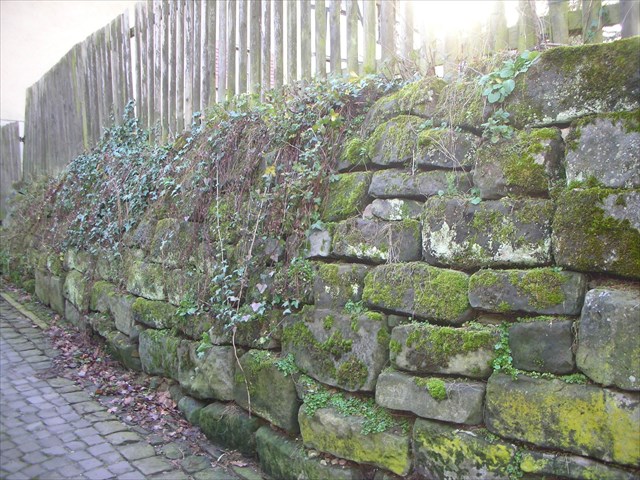
"Die Sandsteine unserer Erde können sehr unterschiedlich aussehen", bemerkt Maribel. "Jedenfalls, was die Farbe betrifft."
"Stimmt", bestätigt Alberto. "Das liegt an den Stoffen, die dem Quarzsand beigemischt sind. Eisen färbt ihn rot, organische Substanzen geben ihm eine schwarze Färbung, von Chlorit wird er grünlich. Wird Quarz nur mit Kieseln zementiert, bleibt er weiß bis grau. Außerdem kann der Härtegrad je nach Druck unterschiedlich sein."
"Dieser Liedberger Sandstein ...... " beginnt Maribel, hält dann aber verschmitzt inne: "....eigentlich könnten die Besucher sich selbst ein Objekt aussuchen und es näher beschreiben, oder? Hier gibt es eine Menge davon!"
"Klar! Und ich schlage vor, daß wir zum Abschluß der Exkursion noch auf den Mühlenturm klettern und die Landschaft von oben betrachten -- es lohnt sich!"
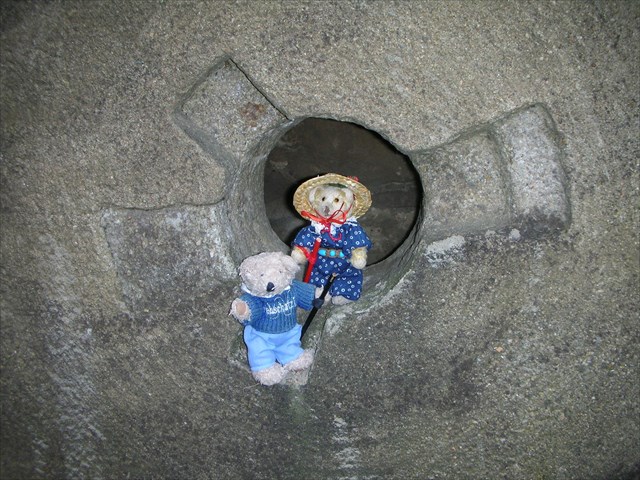
Um diesen Cache zu loggen, beantworte bitte per Mail oder Message Center folgende Fragen:
1.) Was ist ein "Zeugenberg"? Erkläre mit eigenen Worten!
2.) An WP 1 findest du ein Element aus Sandstein.
Welche Färbung weist der Liedberger Sandstein auf?
3.) Was findest du an WP 2:
a) Sandsteinblöcke
b) weiße / schwarze Kiesel
c) feinen Quarzsand
4.) Blicke an WP 3 nach unten. Was siehst du unter deinen Füßen?
Wenn du Alberto gut zugehört hast, weißt du, um welche "Elemente" es sich handelt.
Differenziere zwischen 2 Sorten!
5.) Suche bei deinem Spaziergang durch Liedberg mindestens ein Objekt aus, an dem du Sandstein erkennst.
Beschreibe es mit eigenen Worten!
6.) Der Liedberg heißt auch "Quarzitkuppe". Um welchen Quarzit handelt es sich?
a.) um echten Quarzit?
b.) um sog. Zement-Quarzit?
Hinweis:
Wir haben keine Route vorgegeben. Wandere nach Belieben mit offenen Augen durch Liedberg -- Wald und Ort -- und mache deine Beobachtungen. WP 1 liegt direkt am Parkplatz. Wer auf den Mühlenturm klettern will, braucht 50 Cent Kleingeld!
* * * * * * * * * * * * * * * * * *
ENGLISH:
"This place, Maribel, is called Liedberg. A very special hill in the countryside." Alberto shows on the hilltop in front of them.

"And what's so special about it?" asks Maribel.
"The Liedberg is one of the highest elevations of the Rhine plain. It developed about a million years ago and is the oldest natural and cultural monument of the Rhine-area near Neuss. An outlier of past times, and also the only place with hard rocks at the Lower Rhine. And 'underneath' it is even more interesting." Alberto continues excitedly.
"Phew, that's a whole lot to me! So, maybe you could start explaining what an outlier is? I don´t know that expression yet." Maribel tries to figure things out.
"If a single mountain is isolated by erosion from an erosion-resistant rock mass, it is called an outlier. It testifies previous geological relationships." Alberto explains.
"And because of the solid rock it's probably called a 'quartzite knoll', right? Although I had somehow 'rocky' imagined. The hill is forested."
"Yes, true." Alberto grins. "The quartzite blocks are below the upper humus layer. Among these is the mighty sand storage and even deeper there is a lignite layer."
"Ah, this sand is the 'white gold' of Liedberg," nods Maribel. "Although I wonder how the sand probably came under the mountain! By sand I´d think of the sea beach ...."
"That´s right! But 30 million years ago the North Sea actually ranged up in this area, and it also brought the sand here." Alberto goes back in time. "Here alternated subtropical climate with humid lush vegetation and ice ages which brought glaciers and pebbles, in several turns. Even the Rhine and the Maas gave themselves a 'rendezvous' in Liedberg."
"How do we know that so exactly?" Maribel is skeptical.
"All of these 'actors' leaves its traces," says Alberto. "Always and everywhere! The sea brings the sand and the plants develope to lignite and coal. The tectonic raises, lowers and compresses the earth, and with pressure and temperature sand developes to quartzite, which resulted in the quartzite blocks of Liedberg. Our planet is geologically very active. The white pebbles came here from the Rhine, the round black flints originate from the Ardennes and where brought here by the Maas. They are known as 'Maas-eggs'."

"And on the remains that are found, you can trace back what happened in the past." Maribel is prudent. "Let´s go for a walk through the woods and see if we can find something..."

During this walk over the hilltop however, they must very closely pay attention to discover any indications of the quartzite blocks, pebbles or other geological traces except forest. At first you only see old trees and left and right of the walkway hollows like bomb craters.
"What happened here?" asks Maribel surprised.
"People´s work!" explains Alberto. "The quartzite blocks were taken by open-pit mining, but for the fine quartz sand there were driven many tunnels into the mountain. They took out the sand – and because the heavy sandstone-blocks are above the fine sand, there occurred a lot of collapses."
"Yes, that was very risky and dangerous! There must have been a lot of accidents." Maribel thinks aloud. "The most famous are the scouts, who died in an accident."
"For the scouts there is even a memorial. But a lot more people found their death in that tunnels at sand mining. By the way, Liedberg is probably the only place on Earth where sand was mined underground!"
"Yes, Liedberg already has its peculiarities," confirmed Maribel.
Meanwhile they have crossed the mountain and now are walking an outer circular route. Because Liedberg lies on the slope of a hill, they see lots of half-timbered houses and sandstones in various styles.

"The sandstones of the earth may look very different," noted Maribel. "In any case regarding to the color."
"Right," confirmed Alberto. "This is due to the substances that are added to the quartz sand. Iron gives him red, organic substances give it a black color, of chlorite it gets greenish. If the quartz sand is cemented only with pebbles, it remains white to gray. In addition, the hardness may vary a lot according to the pressure."
"This Liedberger sandstone ..." begins Maribel, but slyly stops and then continues "... actually the visitors themselves could choose an object and describe it in more detail, don´t you think? At least there are enough places here where you find examples of it."
"Yes, sure! And I suggest that we climb that tower called “Mühlenturm” to complete the excursion and see the landscape from above - it's worth it!"

To log this cache, please answer the following questions (mail or Message Center):
1.) What is an outlier? Explain in your own words!
2.) At WP1 you find an item from sandstone.
What color has the Liedberger sandstone?
3.) What do you find at WP 2:
a) sandstone blocks
b) white / black pebbles
c) fine quartz sand
4.) At WP 3 look downwards. What do you see at your feet?
If you listened well to Alberto, you´ll know what objects are meant.
Describe the difference between 2 varieties!
5.) On a walk through Liedberg look out for one or more objects on which you recognize sandstone.
Describe your objects in your own words.
6.) The Liedberg is also called "quartzite knoll". What kind of quartzite is it?
a.) real quartzite?
b.) so-called“cement quartzite”?
Note:
We haven´t set a strict route. Wander at your own will with open eyes through Liedberg - forest and village - and make your observations. WP 1 is the parking lot. Who wants to climb on the mill tower (Mühlenturm) needs 50 cents in coins!
Viel Freude beim Erkunden wünschen Ana Maribel und OXMX und Calimba ---
und natürlich ganz besonders Alberto und Maribel 


 Ein besonderer Dank geht an Amati (Ur-Liedbergerin), die ihre speziellen Erinnerungen mit uns teilte!
Ein besonderer Dank geht an Amati (Ur-Liedbergerin), die ihre speziellen Erinnerungen mit uns teilte! 


*****
Much pleasure by exploring wish you Ana Maribel and OXMX and Calimba---
and particularly Alberto and Maribel 


 Special thanks to Amati (an aborigines), who shared her special memories with us!
Special thanks to Amati (an aborigines), who shared her special memories with us! 


Nützliche Links / Helpful Links:
Quarzit
Quarzitkuppe Liedberg
Zeugenberg
Liedberger Sandstein
Additional Hints
(No hints available.)